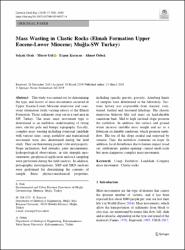Mass Wasting in Clastic Rocks (Elmali Formation Upper Eocene-Lower Miocene; Mugla-SW Turkey)
Abstract
This study was carried out for determining the type, and factors of mass movements occurred in Upper Eocene-Lower Miocene mudstone and sandstone alternation (with varying ratios) of the Elmali Formation. Those sediments crop out in a vast area in SW Turkey. The main mass movement type is determined as an earthflow understanding of tilting trees, electric pole and bumpy topography. Locally, complex mass wasting including rotational landslide with various sizes, creep, earthflow and translational movement were also determined during the field study. They are threatening people's life and property. Slope inclination, bed attitudes, joint measurement, hydrogeological observations, in situ strength measurements, geophysical application and rock sampling were performed during the field analysis. In addition, petrographic investigations, XRF and XRD analyses were performed for determining the contents of sample. Basic physico-mechanical properties, including specific gravity, porosity, Atterberg limits of samples were determined in the laboratory. Tectonic history was responsible from sheared, overturned, faulted and fractured lithology. The chaotic mudstone behaves like soil mass on hard-durable sandstone beds. Mid to high inclined slope promote the earthflow. In addition, the surface and ground water increase unstable mass weight and act as a lubricant on durable sandstone, which promote earthflow. The toe of the slope eroded and removed by streams. Thus, the earthflow continues on slope. In addition, local disturbance due to human impact (road cut, settlements, garden opening) caused small-scale but more dangerous complex mass movement.


















